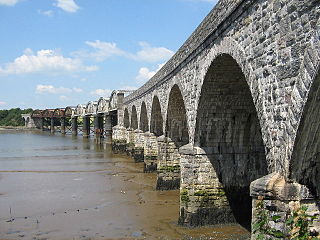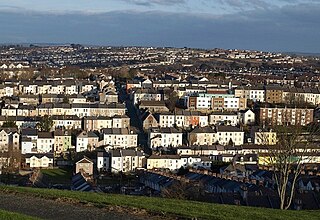
The Tamar Valley Line is a railway line from Plymouth, Devon, to Gunnislake, Cornwall, in England, also known as the Gunnislake branch line. The line follows the River Tamar for much of its route. Like all railway lines in Devon and Cornwall, it is unelectrified and all trains are diesel powered. The entire line is single track past St. Budeaux Junction.

New Hythe railway station is on the Medway Valley Line in Kent, England, serving the village of New Hythe. It is 38 miles 3 chains (61.2 km) down the line from London Charing Cross via Strood and is situated between Snodland and Aylesford. The station and all trains that serve the station are operated by Southeastern.

Plymouth railway station serves the city of Plymouth, Devon, England. It is on the northern edge of the city centre, close to the North Cross roundabout. It Is the second busiest station in the county of Devon, and is the largest of the six surviving stations in Plymouth.

The Plymouth, Devonport and South Western Junction Railway (PD&SWJR) was an English railway company. It constructed a main line railway between Lydford and Devonport, in Devon, England, enabling the London and South Western Railway (LSWR) to reach Plymouth more conveniently than before.

St Budeaux Victoria Road railway station is a suburban station in St Budeaux, Plymouth, Devon, England. The station is managed and served by Great Western Railway.

The South Devon and Tavistock Railway linked Plymouth with Tavistock in Devon; it opened in 1859. It was extended by the Launceston and South Devon Railway to Launceston, in Cornwall in 1865. It was a broad gauge line but from 1876 also carried the standard gauge trains of the London and South Western Railway between Lydford and Plymouth: a third rail was provided, making a mixed gauge. In 1892 the whole line was converted to standard gauge only.
Launceston railway station was situated in Launceston, Cornwall, United Kingdom. It was served by both the Great Western Railway (GWR) and London and South Western Railway (LSWR).
There are eight disused railway stations between Wadebridge and Bodmin North on the former Bodmin and Wadebridge Railway in Cornwall, in the United Kingdom, with ten other closed sidings on the branches to Ruthern Bridge and Wenfordbridge. The section from Boscarne Junction to Bodmin General is currently part of the Bodmin and Wenford Steam Railway; the line from Wadebridge to Wenfordbridge is now part of the Camel Trail, and the line to Ruthern Bridge can be followed for much of its length as it runs parallel to a public road.

Meyrick Park Halt was a railway halt located in the Meyrick Park area of Bournemouth, just west of Bournemouth Central railway station in the county of Hampshire in England.

The Exeter to Plymouth railway of the London and South Western Railway (LSWR) was the westernmost part of a route competing with that of the Great Western Railway (GWR) and its 'associated companies' from London and Exeter to Plymouth in Devon, England. Whereas the GWR route from Exeter followed the coast to Newton Abbot and then went around the southern edge of Dartmoor, the LSWR route followed the northern and western margins of Dartmoor, passing through the towns of Crediton, Okehampton, and Tavistock.

Chevening Halt is a now-closed intermediate railway station on the Westerham branch line in Kent.
Milton Range Halt was a halt between Denton Halt and Hoo Junction Staff Halt on the Hundred of Hoo Railway. It opened in July 1906 and closed to public use on 17 September 1932, although it remained open by special arrangement after that date until some time after 1956. It served Milton Range rifle range.

Lydford railway station was a junction at Lydford between the Great Western Railway (GWR) and London and South Western Railway (LSWR) situated in a remote part of north-west Dartmoor in Devon, England.

The network of railways in Plymouth, Devon, England, was developed by companies affiliated to two competing railways, the Great Western Railway and the London and South Western Railway. At their height two main lines and three branch lines served 28 stations in the Plymouth area, but today just six stations remain in use.

Devonport Kings Road railway station was the London and South Western Railway station in Devonport, Devon, England. It opened in 1876 and closed in 1964. For the first 14 years it was a terminal station with trains to London departing eastwards, but from 1890 it became a through station with trains to London departing westwards.

Plymouth Friary railway station was the London and South Western Railway (LSWR) terminus in Plymouth, Devon, England.
Albert Road Halt was a railway station in Plymouth in the English county of Devon. It was located between Ford and Devonport Park tunnels.

Bryngwyn Halt railway station is a disused station that was on the Llanfyllin Branch of the Cambrian Railways. It served the villages of Bwlch-y-cibau and Brynderwen between 1863 and 1965.
Weston Mill Halt railway station was named after a mill and quay with its lime kiln sitting on Weston Mill Lake next to the River Tamar. The small settlement of Weston Mill also lay near by and the halt was opened as part of Plymouth's suburban network development, together with other halts such as the nearby Camels Head Halt, by the London and South Western Railway in 1906, closing in 1921 or Sunday 4 May 1942. It was located on the outskirts of the city not far from the Great Western Railway main line's Weston Mill Bridge.

Ford (Devon) railway station was originally named Ford railway station and stood at the eastern end of Station Road, Keyham Barton in Plymouth, South Devon.















